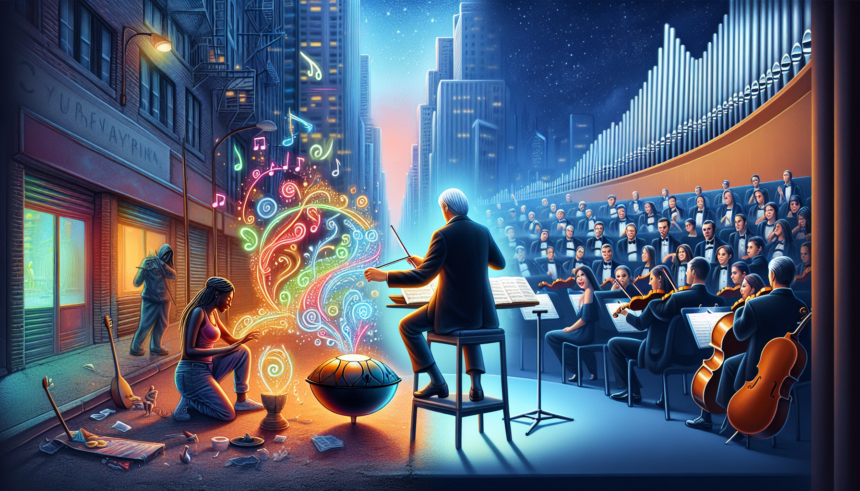From Street Performances to Concert Halls: The Handpan’s Journey in Modern Music
The handpan is a relatively new musical instrument that has rapidly garnered a unique place in the world of modern music. Originating from the steel drum family and relatively unknown a couple of decades ago, the handpan has transcended its humble beginnings to become a staple in various music genres, featured in street performances, concert halls, and even in digital music production. This article explores the handpan’s journey through modern music history, its evolution, and its burgeoning popularity.
Origins and Early Development
Though the handpan itself was only developed in the early 21st century, its roots trace back to older musical traditions. The instrument is a derivative of the steelpan from Trinidad and Tobago. It first emerged when Felix Rohner and Sabina Schärer from the Swiss company PANArt created the first model, known as the Hang, in 2000. Their goal was to craft an instrument that combined the percussive quality of the steel drum with the melodic and harmonic capabilities of other resonance-rich instruments like the steel tongue drum.
Street Performances: The Handpan’s Gateway to the World
The handpan made its initial introduction to the public on the streets. Early adopters of the instrument, including musicians and buskers, found it particularly well-suited for street performances. Its ethereal and soothing tones attracted listeners and created a new auditory experience that stood out amidst the usual street sounds. These performances played an essential role in popularizing the handpan, captivating passersby and earning spots in viral videos that spread across social media platforms.
As street artists embraced the handpan, they experimented with various styles and techniques, adding their touch to the instrument’s developing identity. The handpan’s portability and versatility allowed artists to travel and introduce the sound to diverse audiences worldwide, fostering a growing community of enthusiasts and musicians alike.
The Transition to Concert Halls
The transition of the handpan from street corners to prestigious concert halls was not an overnight phenomenon. Over time, interest in the instrument grew, leading to the integration of the handpan into more formal settings. Professional musicians and performers began including the handpan in their performances and recordings, demonstrating its versatility and capacity to enrich various musical genres.
Classical and contemporary composers started writing pieces that featured the handpan, showcasing its ability to produce hauntingly beautiful melodies. The instrument has appeared in solo recitals, ensemble works, and collaborations with other instrumentalists, crossing the boundaries of jazz, classical, new age, and world music.
Handpan in Modern Music Production
The digital age has seen a significant incorporation of the handpan into modern music production. Producers and composers are utilizing its unique tones to create ambient and experimental soundscapes, utilizing the handpan’s ability to complement both electronic and acoustic instruments. Various digital plugins and virtual handpans have also emerged, enabling producers to incorporate these sounds into their compositions without necessarily owning the physical instrument.
Artists like Manu Delago, one of the foremost handpan players, have showcased the instrument’s potential in electronic music, creating a new genre often referred to as “handpan fusion.” Delago’s collaborations with prominent artists such as Björk and Anoushka Shankar have further cemented the handpan’s place in the modern musical landscape.
Educational Growth and Handpan Communities
The growth of educational resources has also contributed to the handpan’s rising popularity. Workshops, tutorials, and online courses have become increasingly available, allowing aspiring musicians to learn the craft. This educational movement has led to the formation of handpan communities worldwide, where enthusiasts gather to share techniques, compositions, and overall experiences.
International handpan festivals and gatherings have become annual events, celebrating the instrument’s culture and providing a platform for both amateur and professional handpan players to perform and network. These events have been crucial in developing a sense of camaraderie and shared passion within the handpan community.
A Global Phenomenon
The handpan’s journey from street performances to concert halls and modern music production is a testament to its diverse appeal and evocative sound. Today, the handpan is more than just an instrument; it is a connector of cultures and an ambassador of global music fusion. Its ethereal tones continue to mesmerize and inspire musicians, composers, and listeners around the world.
The continued evolution of the handpan promises to keep this instrument in the spotlight for years to come. With musicians constantly experimenting and pushing the boundaries of its capabilities, the handpan’s role in modern music remains dynamic and ever-expanding.
Conclusion
The handpan’s journey from street performances to concert halls highlights its unique charm and versatile nature. Whether played in a bustling city square or a quiet recital hall, the handpan offers an immersive auditory experience that resonates with audiences. Its ongoing evolution and integration into various musical genres reflect its potential to keep captivating listeners and shaping the future of modern music. As more people discover and embrace this extraordinary instrument, the handpan is set to continue its remarkable journey, enchanting audiences worldwide.
FAQs
1. What is a handpan?
A handpan is a type of musical instrument developed in the early 21st century. It is part of the steel drum family and features a convex dome-shaped design, with notes arranged in a circular pattern. The instrument produces ethereal and melodic tunes when struck with the hands.
2. Where did the handpan originate?
The handpan originated from the steelpan family of instruments from Trinidad and Tobago. The first modern handpan, known as the Hang, was created by Swiss musicians Felix Rohner and Sabina Schärer in 2000.
3. Why is the handpan popular in street performances?
The handpan’s popularity in street performances can be attributed to its unique, soothing sound, which captivates listeners in public spaces. Its portability and ease of playing also make it a favored instrument among street musicians.
4. How has the handpan transitioned to concert halls?
The handpan has transitioned to concert halls through the efforts of professional musicians and composers who have integrated it into their performances and compositions. It has been featured in various genres, including classical, jazz, and new age music.
5. Can I learn to play the handpan online?
Yes, there are numerous online resources available for learning to play the handpan. These include tutorials, workshops, and video courses that cater to both beginners and advanced players. Additionally, international handpan festivals and gatherings offer opportunities for hands-on learning and community engagement.





